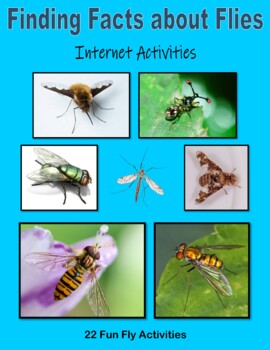Finding Facts about Flies - Internet Activities
The Gifted Writer
881 Followers
Grade Levels
5th - 12th
Subjects
Resource Type
Standards
CCSSW.5.7
CCSSW.6.7
CCSSW.7.7
CCSSW.8.7
CCSSW.9-10.7
Formats Included
- PDF
- Internet Activities
Pages
24 pages
The Gifted Writer
881 Followers
Compatible with Digital Devices
The Teacher-Author has indicated that this resource can be used for device-based learning.
Description
22 printable pages for students to learn about the different types of flies in the world. Students search online for information about the larva and adult forms, what they eat, where they live, whether they are dangerous to humans, etc.
- housefly,
- hoverfly,
- horse fly,
- crane fly,
- flesh fly,
- blow fly,
- tsetse fly,
- goldenrod gall fly,
- bee fly,
- fruit fly,
- midges,
- tachinid fly,
- long-legged fly,
- stalk-eyed fly,
- scavenger fly,
- yellow deer fly,
- flat-footed fly,
- stilt fly,
- picture-winged fly,
- fungus gnat,
- wormlion,
- mosquito.
If you want to see samples pages, then take a look at the Preview.
Total Pages
24 pages
Answer Key
N/A
Teaching Duration
N/A
Last updated Jul 23rd, 2021
Report this resource to TPT
Reported resources will be reviewed by our team. Report this resource to let us know if this resource violates TPT’s content guidelines.
Standards
to see state-specific standards (only available in the US).
CCSSW.5.7
Conduct short research projects that use several sources to build knowledge through investigation of different aspects of a topic.
CCSSW.6.7
Conduct short research projects to answer a question, drawing on several sources and refocusing the inquiry when appropriate.
CCSSW.7.7
Conduct short research projects to answer a question, drawing on several sources and generating additional related, focused questions for further research and investigation.
CCSSW.8.7
Conduct short research projects to answer a question (including a self-generated question), drawing on several sources and generating additional related, focused questions that allow for multiple avenues of exploration.
CCSSW.9-10.7
Conduct short as well as more sustained research projects to answer a question (including a self-generated question) or solve a problem; narrow or broaden the inquiry when appropriate; synthesize multiple sources on the subject, demonstrating understanding of the subject under investigation.





